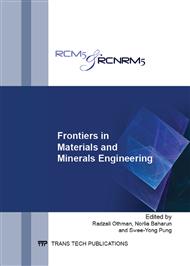[1]
A. S. Reddy, R. K. Pradhan, S. Chandra, Utilization of basic oxygen (BOF) slag in the production of a hydraulic cement binder, Int. J. Miner Process. 79 (2006) pp.98-105.
DOI: 10.1016/j.minpro.2006.01.001
Google Scholar
[2]
J. Li, Q. Yu, J. Wei, T. Zhang, Structural characteristics and hydration kinetics of modified steel slag, Cement Concrete Res. 41(2011) pp.324-329.
DOI: 10.1016/j.cemconres.2010.11.018
Google Scholar
[3]
SEAISI, Overview of steel consumption pattern, in: P. Tepa-Apirak, J. Fong (Eds. ), SEAISI Newsletter July Edition, SEAISI, Malaysia, 2012, p.14.
Google Scholar
[4]
D. M. Proctor, K. A. Fehling, E. C. Shay, J. L. Wittenborn, J. J. Green, C. Avent, R. D. Bigham, M. Connolly, B. Lee, T. O. Shepker, M. A. Zak, Physical and chemical characteristics of blast furnace , basic oxygen furnace, and electric arc furnace steel industry slags, Environ. Sci. & Technol. 34(2000).
DOI: 10.1021/es9906002
Google Scholar
[5]
Lion Group, Lion Industries in tripartite venture for RM30mil slag processing plant, The Star Online Business News Petalng Jaya, Malaysia (2010).
Google Scholar
[6]
F. Engström, D. Adolfsson, C. Samuelsson, Å. Sandström, B. Björkman, A study of the solubility of pure slag minerals, Miner. Eng. 41(2013) p.46–52.
DOI: 10.1016/j.mineng.2012.10.004
Google Scholar
[7]
H. K. Park, M. W. Bae, I. H. Nam, S.G. Kim, Acid leaching of CaO–SiO2 resources, J. Ind Eng Chem, 19 (2013) p.633–639.
Google Scholar
[8]
M. Gelfi, G. Cornacchia, R. Roberti, Investigations on leaching behavior of EAF steel slags, 6th European Slag Conference, Madrid, Spain (2010).
Google Scholar
[9]
L. K. Bankole, S. A. Rezan, N. M. Sharif, N. Baharun, Evaluation of the leaching behavior of hexavalent chromium from Malaysian electric arc furnace steel slag, Advanced Materials Research, Vols. 652-654 (2013) pp.1628-1632.
DOI: 10.4028/www.scientific.net/amr.652-654.1628
Google Scholar
[10]
A. G. Kim, G. Kazonich, M. Dahlberg, Solubility of cations in class F fly ash. Environ. Sci. & Technol. 37 (2003) pp.4507-4511.
DOI: 10.1021/es0263691
Google Scholar
[11]
W. M. Gitari, O. O. Fatoba, L. F. Petrik, V. R. K. Vadapalli, Leaching characteristics of selected South African fly ashes: Effect of pH on the release of major and trace species, J. Environ. Sci. Hlth. Part A(44: 2) (2009) pp.206-220.
DOI: 10.1080/10934520802539897
Google Scholar
[12]
H. Marschner, Mineral nutrition of higher plants, Academic Press, (1995).
Google Scholar
[13]
M. Wazne, S. C. Jagupilla, D. H. Moon, C. Christodoulatos, A. Koutsospyros, Leaching mechanisms of Cr (VI) from chromite ore processing residue, J. environ. qual. 37(2008) pp.2125-2134.
DOI: 10.2134/jeq2007.0443
Google Scholar
[14]
Y. Yao, T. Yoneyama, H. Hayashi, Potassium uptake by Chinese cabbage (Brassica pekinensis Rupy. ) from fused potassium silicate, a slow-releasing fertilizer, Plant Soil, 249 (2003) pp.279-286.
Google Scholar
[15]
C. H. Weng, C. P. Huang, P. F. Sanders, Effect of pH on Cr(VI) Leaching from soil enriched in chromate ore processing residue, Environ. Geochem. Hlth, 23 (2001) pp.207-211.
Google Scholar


